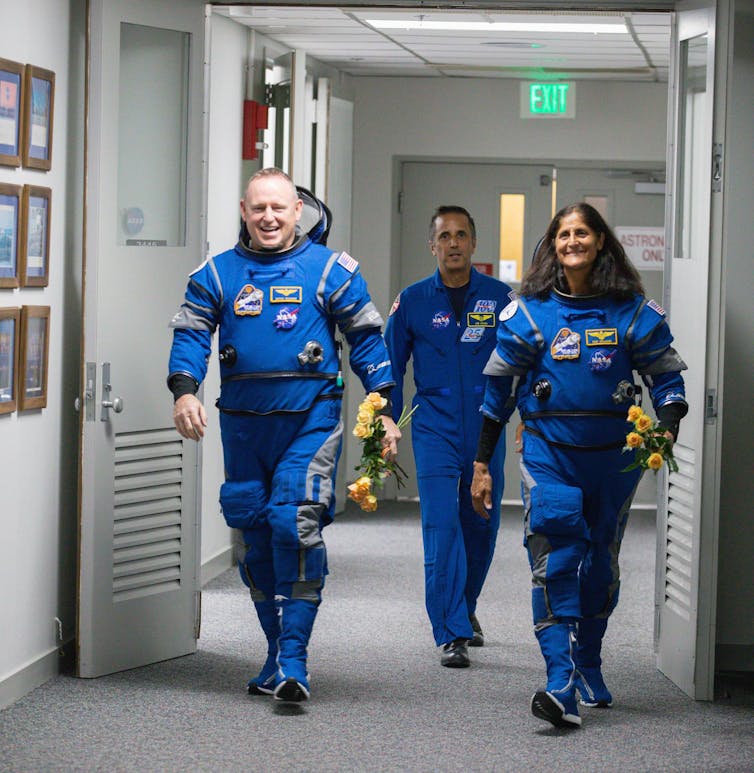For the past few weeks, NASA astronauts Butch Wilmore and Suni Williams have been stranded on the International Space Station (ISS) after the first crewed trip of Boeing’s new Starliner spacecraft hit an obstacle. Concerns raised by Boeing and NASA about problems with the propellant and some helium leaks (helium is used in the Starliner’s propulsion system) have prevented the shuttle from making the return trip as planned. NASA has now said the astronauts may have to stay put until the crew’s next scheduled transfer in August – potentially to another shuttle.
Boeing and NASA are trying to put a positive spin on the extension by saying they are testing systems needed for longer Starliner missions. But the project has already suffered several delays, having originally been set to take off with a crew for the first time in 2017. This, combined with recent problems, raises questions over the entire Starliner program.
The Starliner was noted to have a small helium leak before liftoff. Helium is an inert gas (like neon or xenon), meaning it is very unreactive with other materials.
This makes it ideal when it comes into contact with rocket fuel and high temperatures, although its production is an expensive process. It is pressurized and used to push fuel into the engines at the right speed. Helium leaks can mean that not enough fuel will reach a propellant.
The leak observed while the Starliner was on the launch pad was determined to be negligible, and the spacecraft was sent into orbit regardless. However, this turned into a bigger problem when additional helium leaks were identified after launch, meaning some of the spacecraft’s small maneuvering thrusters could not be used.
Four of the five thrusters have been repaired while the Starliner is docked at the ISS, but that raises concerns about other thrusters being cut off on the return trip to Earth. On the Starliner’s return, re-entry into Earth’s atmosphere requires a very specific “angle of attack” to ensure there isn’t too much friction heating up the craft.

NASA/Kim Shiflett
The inability to adjust the spacecraft’s orientation or orbital parameters for re-entry could, in a worst-case scenario, result in massive heat build-up and destruction of the spacecraft with two astronauts on board.
There are additional thrusters and so-called “redundancies” – backup systems – designed into the spacecraft, so this is a highly unlikely scenario. However, so were the helium leaks. While Boeing and NASA have deemed it safe to return to the Starliner, it’s entirely conceivable that the astronauts could have some trepidation and anxiety — especially since these issues didn’t occur with the uncrewed test flights.
The other particular problem is that the Starliner turns and removes its service module on re-entry as it returns to the surface on land rather than in the sea (as did the Russian Soyuz spacecraft and SpaceX Dragon capsules). This means that the part of the ship with all the vital information will be burned, making it very difficult to determine what actually went wrong.
Space investigations
Ground tests are currently being conducted by NASA and investigations are being conducted on the ISS to gather as much information as possible before return.
The astronauts made it to the ISS and are safe there. While it is likely that the Starliner will return to Earth if a major fault is discovered while it is docked at the ISS, there are other return vehicles that could be used to transport the two crew members home.
Astronaut safety will no doubt be foremost in the minds of the agency and industry. But this is not the first problem with the Starliner. The vehicle has suffered major delays since conception as part of the commercial crew program in 2010.
The contract indicated that the Starliner should be ready by 2017 with a two-year delay before the first successful unmanned launch in 2022 (there was a failed attempt in 2019). The main crewed launch was then delayed by a month.
These delays show that Boeing is lagging behind its main commercial competitor SpaceX, which won a contract at the same time as Boeing in 2010 to build vehicles that could carry crew to the ISS. SpaceX successfully launched a crewed mission with the Dragon capsule in 2020. To give an indication of its success, Crew Dragon is currently completing its fifth manned mission to the ISS, and has also completed 30 cargo missions.
Boeing has been a major player in space missions with NASA for decades, playing a major role in the space shuttle program, for example. That relationship continues with the company’s role in the Space Launch System (SLS) rocket that will send astronauts on their way to the Moon.
The company has been one of the largest and most admired contractors in the aerospace industry. However, the problems with Starliner come not long after the widely publicized incidents with Boeing planes, so the corporation could do without any further problems with its crewed spacecraft to add to its woes.









